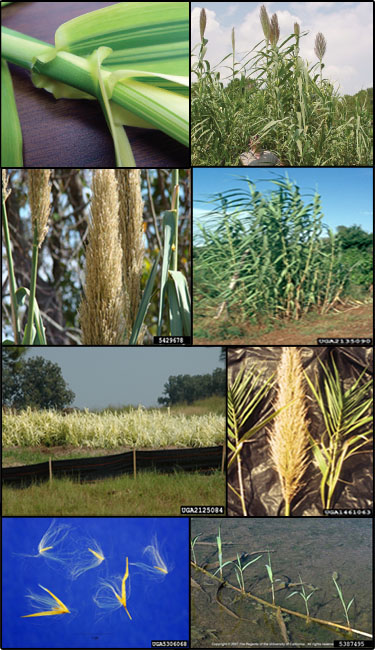Giant reed (Arundo donax)
 Common Names: Elephant grass, wild cane
Common Names: Elephant grass, wild caneDescription: Persistent stalks should be identifiable year round; its clasping leaf bases distinguish it from similar grasses.
Habit: Large, clump-forming perennial; grows from 2-8 m (6.5-26 ft) tall, forms dense monotypic stands.
Leaves: Alternate, clasping, hairy tuft; 30-60 cm (12-24 in) long and 2-6 cm (0.79-2.4 in) wide; tapered tip; grey-green in color.
Stems: 1-8 cm (0.25-2 in) tall, thick, hollow, short distance between nodes results in crowded appearance, resembles a corn stalk.
Flowers: Large, panicle, up to 0.9 m (3 ft) long; blooms late summer to early fall.
Fruit and seeds: Ability to produce seeds but no evidence that seeds are viable.
Habitat: Native to India. Found in shallow stream and river banks, marshes, other open wetlands and ditches, salt-tolerant.
Reproduction: Thick, knotty rhizomes, and fragments, which may be carried by water currents; viable seed rare in North America.
Similar species: Phragmites (Phragmites australis) and Elephant grass (Pennisetum purpureum).
Monitoring and rapid response: Mechanical control is somewhat effective, all fragments must be removed from soil to prevent regrowth. Systemic herbicides, such as glyphosate, may be applied clumps of giant reed, after flowering, either as a cut stump treatment or as a foliar spray. When applying herbicides in or around water or wetlands, be sure to use products labeled for that purpose to avoid harm to aquatic organisms. Credits: The Michigan Natural Features Inventory (MNFI) has partnered with MISIN to provide the information in this fact sheet. Species images and/or information were used with permission from "A Field Identification Guide to Invasive Plants in Michigan's Natural Communities" and "A Field Guide to Invasive Plants of Aquatic and Wetland Habitats for Michigan.
